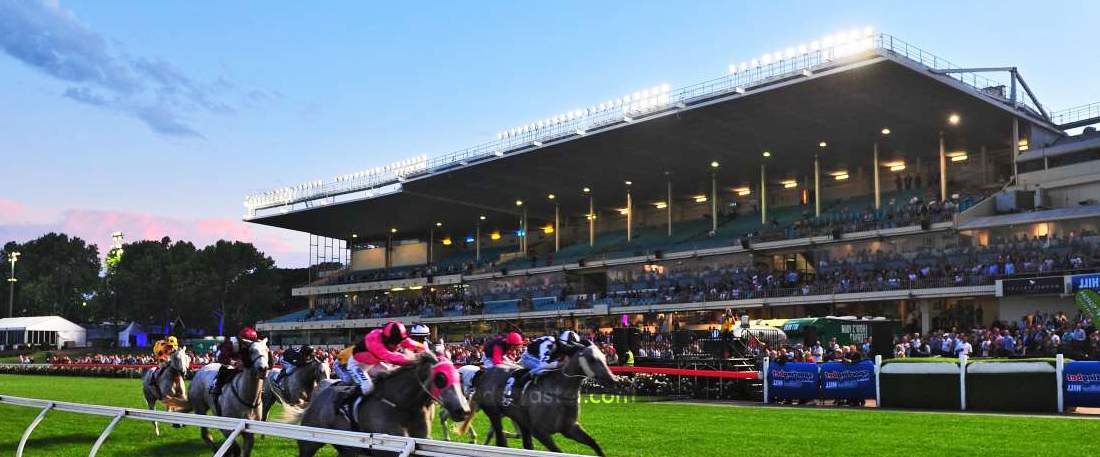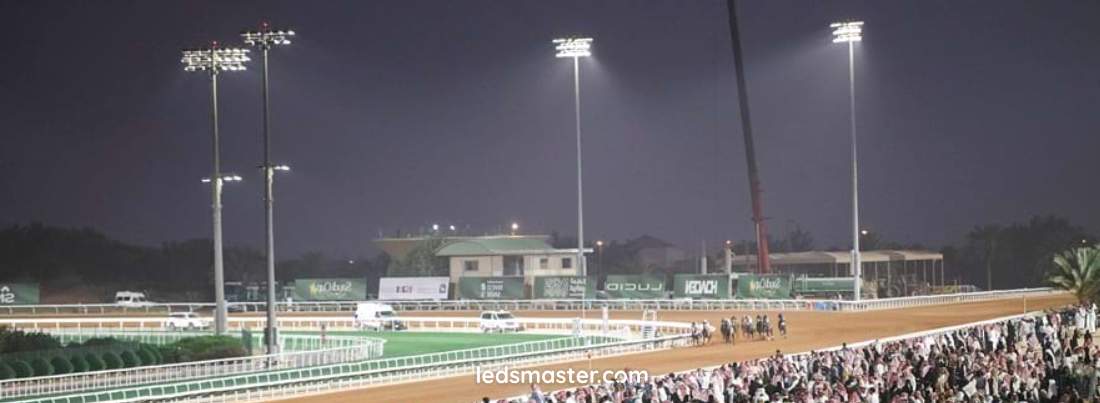From the sturdy and steadfast Fixed Lighting Poles that anchor your illumination needs with reliable, high-intensity fixtures, to the versatile Adjustable Lighting Poles that let you fine-tune your setup for any event, each type brings its own set of benefits. Dive into the different types of racecourse lighting poles and discover how they can transform your racing venue into a beacon of brilliance and style.
Get your complimentary lighting design today
Poles are meticulously engineered to support high-performance lighting systems that illuminate the racetrack with precision and consistency. These poles are designed to hold and stabilize advanced lighting fixtures that deliver powerful and uniform illumination across the entire track.
Table of Contents
ToggleFixed lighting poles represent the most traditional and widely used option for racecourse lighting. These poles are designed for permanent installation, providing a stable and reliable support structure for high-intensity lighting fixtures. Constructed from robust materials such as steel or aluminum, fixed poles are built to endure the rigors of continuous use and environmental exposure. Steel poles are favored for their exceptional strength and durability, making them suitable for supporting large, heavy fixtures. Aluminum poles, while lighter, offer sufficient strength and are resistant to corrosion, which is crucial for long-term outdoor use.

The strategic placement of fixed lighting poles around the racetrack is vital to achieving uniform illumination. The poles are positioned based on detailed lighting plans that consider the track’s layout, size, and the specific requirements for light distribution. The height of fixed poles can vary, often determined by the need to cover large areas effectively and minimize shadows. The design of these poles is focused on ensuring that they provide consistent lighting while meeting industry standards and regulations.
Fixed lighting poles are generally chosen for their reliability and their ability to maintain a steady level of illumination, which is crucial for both daytime and nighttime events. Their permanence ensures that the lighting system remains stable and effective, reducing the need for frequent adjustments or relocations.
Adjustable lighting poles offer enhanced flexibility compared to their fixed counterparts. These poles are equipped with mechanisms that allow for the adjustment of the lighting angles and intensity. This adjustability is particularly beneficial in racecourses where the lighting needs may vary depending on the type of event or specific racing conditions.
For instance, during a major race or a special event, the lighting might need to be concentrated on particular areas of the track to highlight key sections or enhance visibility. Adjustable poles allow for this fine-tuning, ensuring that the light can be directed precisely where it is needed. This capability is also useful for adapting to changing weather conditions or adjusting the lighting to account for different times of day.
The versatility provided by adjustable lighting poles helps in maintaining optimal lighting conditions throughout the event, enhancing both the performance of the horses and the overall spectator experience. These poles often feature mechanical systems or electronic controls that enable quick and easy adjustments, making them a valuable addition to racecourses with dynamic lighting requirements.
Retractable lighting poles offer a unique advantage with their ability to be raised and lowered as needed. This feature provides significant flexibility for racecourses that host a variety of events or have different lighting requirements throughout the year. Retractable poles can be elevated to provide the necessary illumination for a race, and then lowered when not in use, minimizing their impact on the venue’s landscape.
The ability to retract the poles also simplifies maintenance and storage. When not needed, the poles can be lowered to facilitate easier access for repairs or adjustments, and to reduce the visual clutter on the track. This retractability is particularly useful for racecourses that need to maintain a clean and unobstructed area for non-racing activities or for aesthetic reasons.
Retractable lighting poles are designed with mechanisms that allow for smooth and secure operation, ensuring that the poles remain stable when raised and securely locked when lowered. This functionality provides a practical solution for racecourses seeking to balance operational flexibility with aesthetic considerations.
Decorative lighting poles bring an additional layer of visual appeal to racecourses, complementing their functional role with artistic design elements. These poles are crafted with attention to aesthetic detail, enhancing the overall ambiance of the venue. They often feature intricate designs, unique finishes, and artistic flourishes that contribute to the venue’s visual identity.
Incorporating decorative lighting poles can significantly enhance the atmosphere of the racecourse, particularly during special events or evening races. These poles are frequently used in conjunction with advanced lighting technologies to create dynamic and visually captivating effects. For example, decorative poles can be integrated with color-changing LEDs or special light patterns to add a festive or dramatic element to the lighting scheme.
Customization is a key feature of decorative lighting poles, allowing them to be tailored to match the architectural style and theme of the racecourse. This customization can include variations in height, design, and finish, ensuring that the poles not only serve their functional purpose but also contribute to the aesthetic coherence of the venue. By combining practical lighting solutions with artistic design, decorative poles enhance the overall racecourse experience for both participants and spectators.

The intensity and distribution of light are crucial for achieving optimal racecourse illumination. Adequate lighting is essential to ensure that the racetrack is fully visible, whether during daylight or under nighttime conditions. The poles must be engineered to support high-intensity lighting fixtures that are capable of delivering the required lux levels across the entire track. Proper illumination is vital for both the performance of the horses and the experience of the spectators. The light needs to be uniformly distributed to prevent dark spots and shadows that could obstruct the view of the track and potentially affect the race outcome. Advanced lighting systems, often integrated with these poles, use precise optical technologies to enhance light distribution and eliminate glare, creating a clear and consistent visual field.
A well-designed racecourse lighting pole must accommodate a range of lighting fixtures to provide flexibility in illumination. This compatibility ensures that the poles can support various types of lights, including floodlights and LED fixtures, which are essential for modern lighting designs. The poles are typically equipped with adjustable brackets and mounts that facilitate the installation and adjustment of different fixtures. This adaptability allows racecourses to update their lighting systems as needed, whether to integrate new technologies or to tailor the lighting for specific events. Such versatility is valuable for maintaining optimal lighting conditions as technology evolves or as event requirements change.
These poles are subjected to harsh environmental conditions, including high winds, heavy rain, and UV radiation. To withstand these challenges, common materials include steel, aluminum, and galvanized metals, all known for their strength and resistance to corrosion. Steel poles offer robustness and structural integrity, while aluminum poles provide a balance between strength and weight. Galvanized metals, on the other hand, offer excellent resistance to rust and corrosion. The choice of material affects not only the pole’s lifespan but also its maintenance needs. High-quality materials ensure that the poles remain functional and aesthetically pleasing over time, minimizing the need for frequent repairs or replacements.
The height of racecourse lighting poles is determined by the size of the track and the specific lighting needs. Taller poles are generally required for larger tracks to ensure that light is effectively cast over the entire area. The design of the poles involves considerations for both functionality and aesthetics. Aerodynamics play a role in the design to reduce wind resistance and ensure stability. Structural integrity is essential to support the weight of the lighting fixtures and withstand environmental stresses. Additionally, the poles must be designed to complement the overall look of the racecourse, contributing to the venue’s visual appeal. This design balance ensures that the poles are not only effective but also enhance the aesthetic experience for both participants and spectators.
Ease of maintenance is a significant factor in the design of racecourse lighting poles. Regular maintenance is necessary to keep the lighting system in optimal condition, which involves checking for issues such as lamp failures or misalignment. To facilitate this, the poles are often designed with features that allow for easy access to the fixtures. This may include accessible mounting points and components that can be removed or adjusted without extensive effort. Effective maintenance practices help prevent disruptions in lighting and ensure that the racecourse remains well-lit and operational throughout its use.
Energy efficiency is increasingly important in the design of racecourse lighting systems. Modern lighting technologies, particularly LEDs, offer substantial improvements in energy efficiency compared to traditional lighting options such as incandescent or halogen lights. LEDs consume less power and have a longer lifespan, which reduces overall energy consumption and operational costs. Lighting poles that support these energy-efficient fixtures contribute to lower energy bills and a reduced environmental footprint. The shift towards energy-efficient lighting aligns with broader sustainability goals and supports efforts to minimize the racecourse’s impact on the environment.
Safety is a paramount concern in the design and installation of racecourse lighting poles. The poles must be securely anchored to withstand environmental stresses such as high winds and heavy rainfall, preventing accidents or damage. In addition, the lighting system must be designed to minimize glare and ensure that all areas of the track are adequately illuminated. Safety features may include protective covers for the fixtures to shield them from vandalism and environmental damage. Anti-vandalism designs, such as robust mounting systems and tamper-resistant fastenings, help safeguard the lighting infrastructure from potential threats. Ensuring these safety measures are in place is crucial for maintaining a secure and functional lighting system.
By selecting the appropriate type of pole and ensuring that it meets the necessary specifications, racecourses can achieve optimal lighting conditions for both participants and spectators. From fixed and adjustable poles to decorative designs, the variety of options available allows for customized solutions that address specific lighting needs. With considerations for lighting intensity, fixture compatibility, material durability, and energy efficiency, racecourse lighting poles contribute significantly to the overall experience of horse racing events.